p.117
p.122
p.129
p.133
p.138
p.144
p.151
p.158
p.163
Microstructure and Thermo-Physical Properties of TiB2/Si-30Al Composite for Electronic Packaging Applications
Abstract:
2wt.%TiB2/Si-30Al composite was prepared by in-situ reaction and spray forming first and then by hot isostatic pressing (HIP). The microstructure and thermo-physical properties of the composite were investigated by means of scanning electron microscopy, and thermal expansion analyzer respectively. The results show that the microstructure of the TiB2/Si-30Al composite consists of a continuous network of primary Si (~35μm), interpenetrating secondary Al phase, and fine TiB2 particles (1~2μm). The TiB2 particles were uniformly distributed in the Si-30Al alloy matrix. After HIP, the pores in the TiB2/Si-30Al composite were almost eliminated, and the relative density of the composite was up to 98.9%. The 2wt.%TiB2/Si-30Al composite after the HIP exhibits good thermo-physical properties, including lower coefficient of thermal expansion (CTE) (6.6´10-6×K-1) and higher thermal conductivity (84 W×m-1×K-1).
Info:
Periodical:
Pages:
138-143
Citation:
Online since:
June 2011
Authors:
Keywords:
Price:
Сopyright:
© 2011 Trans Tech Publications Ltd. All Rights Reserved
Share:
Citation:


